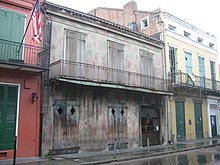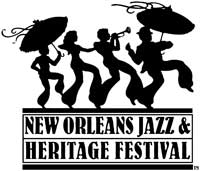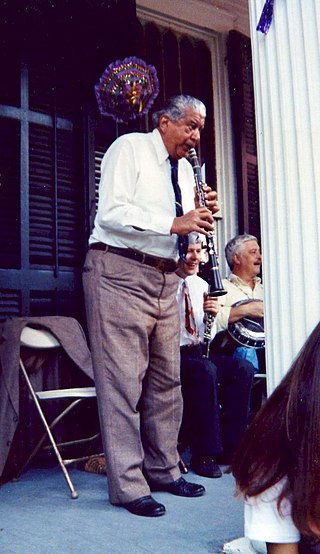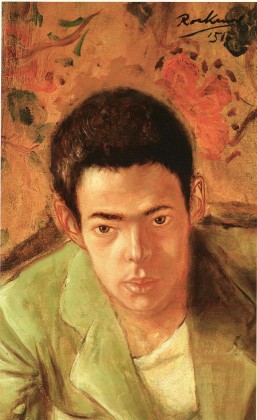
Preservation Hall is a jazz venue in the French Quarter of New Orleans, Louisiana. The building is associated with a house band, a record label, and a non-profit foundation.

Preservation Hall is a jazz venue in the French Quarter of New Orleans, Louisiana. The building is associated with a house band, a record label, and a non-profit foundation.

In the 1950s, art dealer Larry Borenstein from Milwaukee managed what would become Preservation Hall in the French Quarter as an art gallery, Associated Artists. To attract customers, he invited local jazz musicians to play for tips. After a time, the music started drawing more attention than the art. [1] In May 1961, Borenstein turned management over to Ken Grayson Mills and Barbara Reid, who turned it into a music venue and named it "Preservation Hall". [2] [3]
After their honeymoon in 1961, Allan Jaffe and his wife Sandra visited to hear some traditional New Orleans jazz. The Jaffes were from Pennsylvania. Allan Jaffe was a tuba player who had graduated from the Wharton School of Business in Philadelphia, while his wife had been employed at an advertising agency. They attended concerts, grew to love the French Quarter, and stayed longer than they had intended. Borenstein asked if they wanted to manage Preservation Hall, and they agreed, taking over in September 1961. [4]
Allan Jaffe hired local musicians whose ages ranged from the 60s to the 90s. Many were struggling with poverty, racism, and illness. At first, the Jaffes served no alcohol, used no amplification, and refused to advertise. In 1963, Allan Jaffe began to tour with bands in the U.S. and in other countries. These tours included such musicians as pianist Sweet Emma Barrett, trumpeter Kid Thomas Valentine, brothers Percy Humphrey and Willie Humphrey, pianist Billie Pierce and her husband, trumpeter De De Pierce. The most popular was clarinetist George Lewis, whose reputation preceded the Hall. Fans from all over the world came to New Orleans to hear traditional jazz. [4]
The Preservation Hall Foundation is a 501(c)(3) organization primarily dedicated to Preservation Hall's educational initiatives, including but not limited to providing private lessons to youth taught by New Orleans jazz musicians, coordinating group lessons with the Preservation Hall Junior Jazz Band, presenting workshops during Preservation Hall Jazz Band tours, or maintenance of the ever-growing Preservation Hall archives. The Foundation also provides a free online learning resource for music educators and students called the Preservation Hall Foundation Brass Bandbook including the songs "Bourbon Street Parade", "Just a Closer Walk with Thee", "Lil' Liza Jane", "Down by the Riverside", "Didn't He Ramble", "Lord, Lord, Lord", "I'll Fly Away", "Joe Avery's Piece", "Paul Barbarin's Second Line", "Old Rugged Cross", "By and By", and "Do Whatcha Wanna". [5]

George Lewis was an American jazz clarinetist who achieved his highest profile in the later decades of his life.

The New Orleans Jazz & Heritage Festival is an annual celebration of local music and culture held at the Fair Grounds Race Course in New Orleans, Louisiana. Jazz Fest attracts thousands of visitors to New Orleans each year. The New Orleans Jazz & Heritage Festival and Foundation Inc., as it is officially named, was established in 1970 as a 501(c)(3) nonprofit organization (NPO). The Foundation is the original organizer of the New Orleans Jazz & Heritage Festival presented by Shell Oil Company, a corporate financial sponsor. The Foundation was established primarily to redistribute the funds generated by Jazz Fest into the local community. As an NPO, their mission further states that the Foundation "promotes, preserves, perpetuates and encourages the music, culture and heritage of communities in Louisiana through festivals, programs and other cultural, educational, civic and economic activities". The founders of the organization included pianist and promoter George Wein, producer Quint Davis and the late Allison Miner.
Raymond Burke was an American jazz clarinetist.

The Preservation Hall Jazz Band is a New Orleans jazz band founded in New Orleans by tuba player Allan Jaffe in the early 1960s. The band derives its name from Preservation Hall in the French Quarter. In 2005, the Hall's doors were closed for a period of time due to Hurricane Katrina, but the band continued to tour.
Narvin Kimball was a jazz musician who played 4-string banjo and string bass and was also known for his fine singing voice.

Percy Gaston Humphrey was an American jazz trumpeter and bandleader in New Orleans, Louisiana.

George Colar, actually Cola but he used Colar, better known as Kid Sheik or Kid Sheik Cola, was a New Orleans jazz trumpeter and band leader who was born in New Orleans September 15, 1908, and passed in Detroit November 7, 1996. He is most associated with Dixieland jazz and was a long-term performer with the Preservation Hall Jazz Band. His nickname "Kid Sheik" came from his chic style of clothing as he wore sheik suites as a young man.

Louis Hall Nelson was an American jazz trombonist.
E. Lorenz "Larry" Borenstein (1919–1981) was an American property owner, art dealer and the "Father of Preservation Hall".

Willie James Humphrey was a New Orleans jazz clarinetist. Willie Humphrey was born in a musical family, the son of prominent local clarinetist and music teacher Willie Eli Humphrey; his brothers Earl Humphrey and Percy Humphrey also became well known professional musicians.

Lars Ivar Edegran is a Dixieland jazz musician and bandleader from Sweden. He most often plays piano, guitar, or banjo but has also played mandolin, clarinet, and saxophone.

The Olympia Brass Band is an American jazz brass band from New Orleans.

Louis Albert Cottrell Jr. was a Louisiana Creole jazz clarinetist and tenor saxophonist. He was the son of the influential drummer Louis Cottrell, Sr., and grandfather of New Orleans jazz drummer Louis Cottrell III. As leader of the Heritage Hall Jazz Band, he performed at Carnegie Hall in 1974.

Thomas Alexander Sancton is an American writer, jazz clarinetist and educator. From 1992 to 2001 he was Paris bureau chief for TIME Magazine, where he worked for 22 years, and he has contributed to numerous publications including Vanity Fair, Fortune, Newsweek and the Wall Street Journal. His acclaimed memoir, Song for My Fathers: a New Orleans Story in Black and White (2006), recounts his early life among traditional jazzmen in his native New Orleans. He taught journalism at the American University of Paris from 2002 to 2004. In 2007 he was named Andrew W. Mellon Professor in the Humanities at Tulane University, where he taught creative writing until 2011. He is currently a Research Professor at Tulane.

Allan Phillip Jaffe was an American jazz tubist and the entrepreneur who, along with his wife Sandra, developed Preservation Hall into a New Orleans jazz tradition.

Noel Rockmore was born Noel Montgomery Davis to his mother, Gladys Rockmore Davis, and his father, Floyd Davis, in New York City. Rockmore was an American painter, draughtsman, and sculptor. He claimed to have produced more than 15,000 works of art in his lifetime. He is known for his portraits, his early rise to fame, his Preservation Hall portraits, and for changing his name at the height of the popularity he had developed in New York City and he had a daughter, Emilie Rhys

Benjamin Jaffe is the creative director of Preservation Hall and plays tuba and double bass with the Preservation Hall Jazz Band.

James Brown Humphrey, also known as "Professor Jim" Humphrey (1859–1937) was an American classical musician, dance band leader, and music instructor in New Orleans, Louisiana, and central figure in the formation of jazz as a contemporary musical art form. Humphrey predates the jazz genre as an active performer and is not himself considered a jazz musician. However, his involvement in the formal training of large numbers of musicians along the southern plantation belt of the Mississippi River delta during the immediate years following the reconstruction era resulted in many virtuoso performers who would go on to originate jazz as a distinct musical genre. Consequently, he is regarded by some in the jazz aficionado community to be "the grandfather of jazz".

Dave Albert Williams Jr. was an American jazz, blues, and rhythm & blues pianist, bandleader, singer, and songwriter. He was the author of "I Ate Up The Apple Tree", a staple of contemporary New Orleans brass bands. His career as a working musician spanned five decades.

Paul Crawford was an American jazz musician, music arranger, and music historian. He specialized in Dixieland jazz.